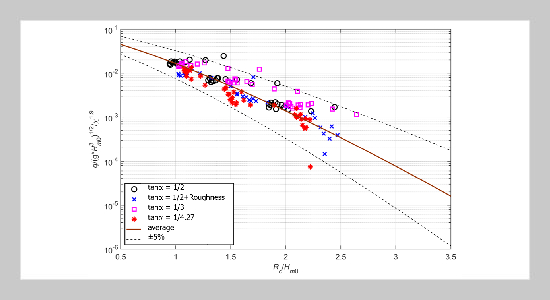- [1] E. Beetham and P. S. Kench, (2018) “Predicting wave overtopping thresholds on coral reef-island shorelines with future sea-level rise" Nature Communications 9(1): 3997. DOI: 10.1038/s41467-018-06550-1.
- [2] Y. Liu, Z. Liao, K. Fang, and S. Li, (2021) “Uncertainty of wave runup prediction on coral reef-fringed coasts using SWASH model" Ocean Engineering 242: 110094.
- [3] A. Pomeroy, R. Lowe, G. Symonds, A. Van Dongeren, and C. Moore, (2012) “The dynamics of infragravity wave transformation over a fringing reef" Journal of Geophysical Research: Oceans 117(C11):
- [4] Q. C. Dinh, Q. T. Nguyen, D. D. Ho, and C. T. Mai, (2023) “Effects of bottom roughness on wave transmission across a submerged reef" Frontiers in Marine Science 10: 1113195.
- [5] K. Splinter, L. Li, and M. Blacka, (2018) “Laboratory Experiments Of Wave Overtopping Of Revetment Struc�tures In Reef Environments" Coastal Engineering Pro�ceedings (36): 80–80.
- [6] S. K. Paul and W. B. Robert, (2006) “Wave Processes on Coral Reef Flats: Implications for Reef Geomorphol�ogy Using Australian Case Studies" Journal of Coastal Research 22(1): 209–223.
- [7] M. L. Buckley, R. J. Lowe, J. E. Hansen, and A. R. Van Dongeren, (2015) “Dynamics of Wave Setup over a Steeply Sloping Fringing Reef" Journal of Physical Oceanography 45(12): 3005–3023. DOI: 10.1175/jpo�d-15-0067.1.
- [8] O. Nwogu and Z. Demirbilek, (2010) “Infragravity wave motions and runup over shallow fringing reefs" Journal of Waterway, Port, Coastal, and Ocean En�gineering 136(6): 295–305.
- [9] J. M. Becker, M. A. Merrifield, and M. Ford, (2014) “Water level effects on breaking wave setup for Pacific Is�land fringing reefs" Journal of Geophysical Research: Oceans 119(2): 914–932. DOI: https://doi.org/10.1002/2013JC009373.
- [10] A. Sheremet, R. Guza, S. Elgar, and T. Herbers, (2002) “Observations of nearshore infragravity waves: Seaward and shoreward propagating components" Journal of Geophysical Research: Oceans 107(C8): 10-1-10–10.
- [11] V. Roeber and J. D. Bricker, (2015) “Destructive tsunami-like wave generated by surf beat over a coral reef during Typhoon Haiyan" Nature Communications 6(1): 7854. DOI: 10.1038/ncomms8854.
- [12] O. M. Cheriton, C. D. Storlazzi, and K. J. Rosenberger, (2016) “Observations of wave transformation over a fring�ing coral reef and the importance of low-frequency waves and offshore water levels to runup, overwash, and coastal flooding" Journal of Geophysical Research: Oceans 121(5): 3121–3140. DOI: https://doi.org/10.1002/2015JC011231.
- [13] C. D. Storlazzi, W. J. Skirving, J. J. Marra, R. T. McCall, and A. W. Pomeroy, (2021) “Flooding on coral reef-lined coasts: Current state of knowledge and future challenges" Frontiers in Marine Science:
- [14] M. A. Merrifield, J. M. Becker, M. Ford, and Y. Yao, (2014) “Observations and estimates of wave-driven water level extremes at the Marshall Islands" Geophysical Research Letters 41(20): 7245–7253. DOI: https://doi.org/10.1002/2014GL061005.
- [15] H. Burchartch and S. Hughes. Coastal Engineering Manual, Fundamentals of design. Vicksburg, USA: US Army Corps of Engineering, 2003.
- [16] J. De Rouck, C. Boone, and B. Van de Walle. The opti�misation of crest level design of sloping coastal structures through prototype monitoring and modelling, final report. Report. 2001.
- [17] J. W. van der Meer, H. Verhaeghe, and G. J. Steendam, (2009) “The new wave overtopping database for coastal structures" Coastal Engineering 56(2): 108–120. DOI: https://doi.org/10.1016/j.coastaleng.2008.03.012.
- [18] J. W. Van der Meer, (1995) “Wave run-up and wave overtopping at dikes" ASCE:
- [19] J. Van der Meer, N. Allsop, T. Bruce, J. De Rouck, A. Kortenhaus, T. Pullen, H. Schuttrumpf, P. Troch, B. Zanuttigh, et al., (2016) “EurOtop-Manual on wave overtopping of sea defences and related structures. An overtopping manual largely based on European research, but for worldwide application."
- [20] C. Altomare, T. Suzuki, X. Chen, T. Verwaest, and A. Kortenhaus, (2016) “Wave overtopping of sea dikes with very shallow foreshores" Coastal Engineering 116: 236–257. DOI: https://doi.org/10.1016/j.coastaleng.2016.07.002.
- [21] Y. Liu, S. Li, S. Chen, C. Hu, Z. Fan, and R. Jin, (2020) “Random wave overtopping of vertical seawalls on coral reefs" Applied Ocean Research 100: 102166.
- [22] Y. Liu, S. Li, X. Zhao, C. Hu, Z. Fan, and S. Chen, (2020) “Artificial neural network prediction of overtop�ping rate for impermeable vertical seawalls on coral reefs" Journal of Waterway, Port, Coastal, and Ocean En�gineering 146(4): 04020015.
- [23] Y. Gao, L. Ren, and L. Wang, (2023) “Experimental Investigation of Wave Propagation and Overtopping over Seawalls on a Reef Flat" Journal of Marine Science Engineering 11(4): 836.
- [24] T. Q. Tuan and D. Q. Cuong. “Wave transmission across steep submerged reefs”. In: APAC 2019: Pro�ceedings of the 10th International Conference on Asian and Pacific Coasts, 2019, Hanoi, Vietnam. Springer, 687–694.
- [25] T. Q. Tuan and D. Q. Cuong, (2019) “Distribution of wave heights on steep submerged reefs" Ocean Engineer�ing 189: DOI: 10.1016/j.oceaneng.2019.106409.
- [26] J. Zelt and J. E. Skjelbreia, (1992) “Estimating incident and reflected wave fields using an arbitrary number of wave gauges" Coastal Engineering 1992: 777–789.
- [27] J. A. Battjes, H. J. Bakkenes, T. T. Janssen, and A. R. van Dongeren, (2004) “Shoaling of subharmonic gravity waves" Journal of Geophysical Research 109(C2): DOI: https://doi.org/10.1029/2003JC001863.
- [28] T. E. Baldock, (2012) “Dissipation of incident forced long waves in the surf zone—Implications for the concept of “bound” wave release at short wave breaking" Coastal Engineering 60: 276–285. DOI: https://doi.org/10.1016/j.coastaleng.2011.11.002.
- [29] B. Hofland, X. Chen, C. Altomare, and P. Oosterlo, (2017) “Prediction formula for the spectral wave period Tm-1,0 on mildly sloping shallow foreshores" Coastal Engineering 123: 21–28. DOI: https://doi.org/10.1016/j.coastaleng.2017.02.005.
















